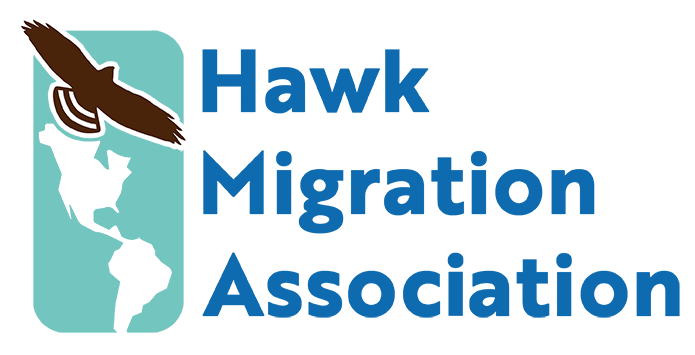The Kittatinny Roundtable, hosted by Hawk Mountain Sanctuary, is a fun and exciting day-long event for hawk watch coordinators from Pennsylvania, Maryland, New Jersey, and Delaware. For roughly 40 years, coordinators within driving distance have gathered in the summer before raptor migration starts again to review hawk count results from the previous year.
Emceed by Laurie Goodrich, this year’s July event brought together more than 35 coordinators to analyze the highlights and lowlights of the past fall and spring seasons. Laurie also arranges several presentations on current raptor research, some by citizen scientists and others by Hawk Mountain staff.
This year’s session opened with an update from HMANA’s monitoring site coordinator, Julie Brown, about our current programs, activities, and plans for the future. She also brought some HMANA merchandise for sale, and she happily didn’t return home with much!
Next, we heard from Nick Bolgiano, a now-retired biostatistician who counts at Stone Mountain and has produced some outstanding raptor research. His latest is about how the West Nile virus (WNV) impacts bird populations, including raptors.
Nick tells us, “Raptors can acquire WNV by eating an infected host. The raptors most commonly found dead in the US from WNV have been Red-tailed Hawk, Great Horned Owl, Cooper’s Hawk, Sharp-shinned Hawk, and American Kestrel. WNV-related research on raptors has included observational studies of infected raptors, necropsies of dead raptors, intentional infections or challenge studies, and comparisons of reproduction for raptor parents with and without WNV antibodies. However, other than for Great Horned Owl, WNV is not currently known to be affecting raptor population numbers.” He reports that the young of Great Horned Owl and the grouse family seem particularly hard hit by the virus.
After the initial epidemic, the WNV epidemic dropped off in many regions, and it seemed as if bird populations were largely unscathed. However, that has not been the recent case in Pennsylvania. The Department of Environmental Protection has annually measured the WNV prevalence in sampled mosquitoes and estimated an index of the number of infected mosquitoes. This estimated prevalence re-amplified to a high level in 2012 and then a much higher level in 2018, nearly four times the long-term average. Christmas Bird Count (CBC) shows that effort-adjusted counts of American Crows, Great Horned Owls, Ruffed Grouse, Black-capped and Carolina Chickadees, and Tufted Titmice have sharply declined, and there is additional corroboratory evidence for why WNV is the cause.
Nick reports, “Four diurnal raptor species stand out as having possible evidence for WNV effects: the three accipiters, Sharp-shinned Hawk, Cooper’s Hawk, and Northern Goshawk, plus Red-tailed Hawk. For each, there are some Raptor Population Index trends from eastern hawk watches that decline, some dramatically, starting around 2000. For Sharp-shinned Hawk, CBC densities around the Chesapeake and Delaware Bays also begin to decline around that time sharply. For Cooper’s Hawk and Red-tailed Hawk, there is additional evidence for migratory short-stopping, whose effect may be difficult to discern from WNV-related declines.” Nick wrote an article about his study that is published in the current issue of Pennsylvania Birds magazine.
Later in the day, we also saw some great photos by Paul Fritz about raptors displaying unusual behaviors. We saw small birds attacking large raptors, a feisty Peregrine attacking a Pelican near her nest, and an Osprey eating (after presumably killing) a rabbit and others.
Hawk Mountain’s David Barber is doing some outstanding research on Turkey and Black Vultures, with information garnered from satellite tracking of the birds. For example, the tracked Turkey Vultures from the east are found to winter exclusively in Florida or the southeast. At the same time, it’s only birds from the central and western US who migrate into Mexico, through Veracruz, and beyond.
A fun and exciting portion of the day looks at the migration statistics along the Kittatinny Ridge. Coordinators from each site report their peak days and numbers for individual species and their seasonal totals. There’s always good news and bad news, as well as a healthy competition to see who has seen more (or less). For instance, Raccoon Ridge, NJ, and Bake Oven and Hawk Mountain (both PA) all had their most extensive Broad-winged Hawk flights on September 15 and 16, 2018. However, the most important day at Scotts Mountain’s, NJ; Militia Hill, PA; Rose Tree Park, PA; and Ashland, DE, was September 22, clearly indicating a second wave of the hawks. Another species the group examined in detail was Northern Harrier, where only one site (Jack’s Mountain) reported an uptick in sightings. All the other sites reported low results for Harrier, though Bake Oven, Hawk Mountain, Stone Mtn. and Militia hill indicated their results were “about average” for the species. Better news was found for Merlin, where all but two sites reported above-average results.
The Kittatinny Roundtable is a great way to spend the day “hawk watching” in the middle of summer. Any region where hawk watches are grouped near each other would be an excellent candidate to replicate this event. If your area wants to try and do so, please contact Julie Brown for further details.



